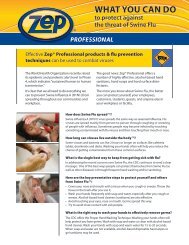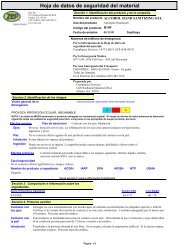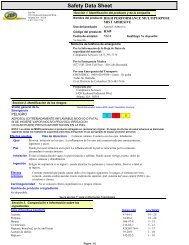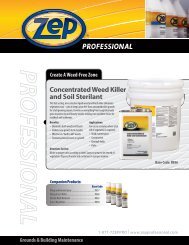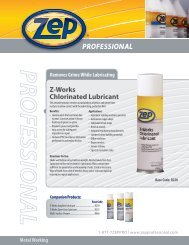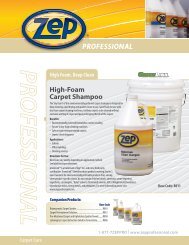Material Safety Data Sheet - Zep Professional
Material Safety Data Sheet - Zep Professional
Material Safety Data Sheet - Zep Professional
Create successful ePaper yourself
Turn your PDF publications into a flip-book with our unique Google optimized e-Paper software.
<strong>Material</strong> <strong>Safety</strong> <strong>Data</strong> <strong>Sheet</strong><br />
<strong>Zep</strong> Inc.<br />
1310 Seaboard Industrial Blvd.<br />
Atlanta, GA 30318<br />
1-877-793-7776<br />
Section 1. Chemical Product and Company Identification<br />
Product name ALKALINE DRAIN OPENER<br />
Product use Sewer and Drain Cleaner - Alkaline Liquid<br />
Product code R027<br />
Date of issue 08/05/08 Supersedes<br />
Emergency Telephone Numbers<br />
For MSDS Information:<br />
Compliance Services 1-877-793-7776<br />
For Medical Emergency<br />
INFOTRAC: (877) 541-2016 Toll Free - All Calls<br />
Recorded<br />
For Transportation Emergency<br />
CHEMTREC: (800) 424-9300 - All Calls Recorded<br />
In the District of Columbia (202) 483-7616<br />
Prepared By<br />
Compliance Services<br />
1420 Seaboard Industrial Blvd.<br />
Atlanta, GA 30318<br />
Section 2. Hazards Identification<br />
Emergency overview<br />
*Hazard Determination System (HDS): Health, Flammability, Reactivity<br />
DANGER ! POISON<br />
CAUSES EYE AND SKIN BURNS. Corrosive to skin, eyes, and<br />
mucous membranes.<br />
HARMFUL OR FATAL IF SWALLOWED.<br />
3 0 1<br />
NOTE: MSDS data pertains to the product as delivered in the original shipping container(s). Risk of adverse effects are lessened by following all<br />
prescribed safety precautions, including the use of proper personal protective equipment.<br />
Acute Effects Routes of Entry Dermal contact. Eye contact. Inhalation.<br />
Eyes Corrosive to eyes on contact. Eye exposure may cause severe and permanent eye injury<br />
(blindness).<br />
Skin Corrosive to skin on contact. Causes skin burns. The amount of tissue damage depends on length<br />
of contact. Skin inflammation is characterized by itching, scaling, reddening or, occasionally,<br />
blistering.<br />
Inhalation Corrosive to the respiratory system. Avoid inhalation of vapor, spray or mist. Liquid, spray or<br />
mist may produce tissue damage, particularly to mucous membranes of eyes, mouth and<br />
respiratory tract.<br />
Ingestion May be fatal if swallowed. May cause burns to mouth, throat, and stomach.<br />
Chronic effects Repeated or prolonged contact with spray or mist may produce chronic eye irritation and severe<br />
skin irritation. Repeated or prolonged exposure to spray mist may produce respiratory tract<br />
irritation leading to frequent attacks of bronchial infection. Repeated or prolonged exposure to<br />
the substance can produce mucous membranes damage.<br />
Carcinogenicity Ingredients: Not listed as carcinogen by OSHA, NTP or IARC.<br />
Additional Information: See Toxicological Information (Section 11)<br />
Section 3. Composition/Information on Ingredients<br />
Name of Hazardous Ingredients CAS number % by Weight<br />
SODIUM TRIPOLYPHOSPHATE 7758-29-4 1 - 10<br />
POTASSIUM HYDROXIDE; caustic potash; lye 1310-58-3 1 - 5<br />
SODIUM HYPOCHLORITE; hypochlorous acid, sodium salt; bleach 7681-52-9 1 - 5<br />
Section 4. First Aid Measures<br />
Eye Contact<br />
Skin Contact<br />
Inhalation<br />
Immediately flush eyes with plenty of water, occasionally lifting the upper and lower eyelids. Check for and<br />
remove any contact lenses. Continue to rinse for at least 10 minutes. Get medical attention immediately.<br />
Flush contaminated skin with plenty of water. Remove contaminated clothing and shoes. Continue to rinse for at<br />
least 10 minutes. Wash clothing before reuse. Get medical attention immediately.<br />
If inhaled, remove to fresh air. If not breathing, give artificial respiration. If breathing is difficult, give oxygen.<br />
Get medical attention immediately.<br />
Page: 1/3
Page: 2/3<br />
Product code R027<br />
<strong>Material</strong> <strong>Safety</strong> <strong>Data</strong> <strong>Sheet</strong><br />
Product Name ALKALINE DRAIN OPENER<br />
Ingestion<br />
Do not induce vomiting unless directed to do so by medical personnel. Never give anything by mouth to an<br />
unconscious person. If affected person is conscious, give plenty of water to drink. Get medical attention<br />
immediately.<br />
Section 5. Fire Fighting Measures<br />
Flash Point<br />
Flammable Limits<br />
Flammability<br />
Fire hazard<br />
Fire-Fighting<br />
Procedures<br />
None.<br />
Not applicable<br />
Non-combustible.<br />
National Fire Protection Association (U.S.A.)<br />
3 0 1<br />
Reacts violently with water. Flammable hydrogen gas may be produced on prolonged contact<br />
with metals such as aluminum, tin, lead and zinc.<br />
Use an extinguishing agent suitable for the surrounding fire. Fire-fighters should wear<br />
appropriate protective equipment. Do not release runoff from fire to sewers or waterways.<br />
Section 6. Accidental Release Measures<br />
Spill Clean up<br />
Put on appropriate personal protective equipment (see section 8). Stop leak if without risk. Move containers<br />
from spill area. Absorb with an inert material and place in an appropriate waste disposal container. Dispose of<br />
via a licensed waste disposal contractor.<br />
Section 7. Handling and Storage<br />
Handling<br />
Storage<br />
Put on appropriate personal protective equipment (see section 8). Avoid contact with eyes, skin and clothing. DO<br />
NOT breathe vapors or spray mist. Use only with adequate ventilation. Do not ingest. Do not reuse container. Do<br />
not use with other products. Observe label precautions. When making solutions or diluting, add product slowly to<br />
surface of cold water while stirring. Do not add to warm or hot water as a violent eruption can result. Wash<br />
thoroughly after handling.<br />
Store away from incompatible materials. Flammable hydrogen gas may be produced on prolonged contact with metals<br />
such as aluminum, tin, lead and zinc. Keep container tightly closed and sealed until ready for use. Keep container in a<br />
cool, well-ventilated area. Store between the following temperatures: 40°F - 120°F (4.4°C - 49°C). Keep out of the<br />
reach of children.<br />
Section 8. Exposure Controls/Personal Protection<br />
Product name<br />
POTASSIUM HYDROXIDE; caustic potash; lye<br />
Personal Protective Equipment (PPE)<br />
Eyes<br />
Body<br />
Respiratory<br />
Exposure limits<br />
ACGIH /OSHA (United States).<br />
CEIL: 2 mg/m³<br />
Splash goggles. Face shield.<br />
Wear appropriate protective clothing to prevent skin contact.<br />
Recommended: Rubber gloves. Neoprene gloves. Wear apron or<br />
coverall if there is a risk of exposure to splashes. Chemical resistant<br />
boots.<br />
Use with adequate ventilation. Provide exhaust ventilation or other engineering<br />
controls to keep the airborne concentrations of vapors below their respective<br />
occupational exposure limits. Wear appropriate respirator when ventilation is<br />
inadequate.<br />
Section 9. Physical and Chemical Properties<br />
Physical State<br />
pH<br />
Boiling Point<br />
Specific Gravity<br />
Solubility<br />
Liquid.<br />
13.0 - 14.0<br />
135°C (275°F)<br />
1.45<br />
Easily soluble in the following materials: cold water<br />
and hot water.<br />
Color Red. [Dark]<br />
Odor Odorless.<br />
Vapor Pressure Not determined.<br />
Vapor Density Not determined.<br />
Evaporation Rate 1 (Water = 1)<br />
VOC (Consumer) 0 (g/l).<br />
Section 10. Stability and Reactivity<br />
Stability and Reactivity The product is stable.<br />
Incompatibility<br />
Do not use with other products. May generate heat on contact with water. Incompatible with<br />
aluminum and magnesium. Slightly reactive or incompatible with the following materials:<br />
oxidizing materials, reducing materials, metals and acids.<br />
Hazardous Polymerization Will not occur.<br />
Hazardous Decomposition Products Under normal conditions of storage and use, hazardous decomposition products should not be<br />
produced.
Product code R027<br />
<strong>Material</strong> <strong>Safety</strong> <strong>Data</strong> <strong>Sheet</strong><br />
Product Name ALKALINE DRAIN OPENER<br />
Section 11. Toxicological Information<br />
Acute Toxicity<br />
Product/ingredient name Result Species Dose Exposure<br />
Potassium Hydroxide LD50 Oral Rat 365 mg/kg -<br />
Section 12. Ecological Information<br />
Environmental Effects No known significant effects or critical hazards.<br />
Aquatic Ecotoxicity<br />
Product/ingredient name Test Result Species Exposure<br />
Potassium Hydroxide - Acute LC50 179 mg/L Fish 96 hours<br />
Section 13. Disposal Considerations<br />
Waste Information<br />
Waste must be disposed of in accordance with federal, state and local environmental control regulations. Consult your local or<br />
regional authorities for additional information.<br />
Waste Stream<br />
Code: D002<br />
Classification: - [Hazardous waste]<br />
Origin: - [RCRA waste.]<br />
Section 14. Transport Information<br />
Regulatory information UN number Proper shipping name Classes PG* Label<br />
DOT Classification<br />
3266<br />
Corrosive liquid, Basic,<br />
Inorganic, NOS (Potassium<br />
Hydroxide)<br />
8 II<br />
CORROSIVE<br />
8<br />
IMDG Class<br />
Not determined.<br />
NOTE: DOT classification applies to most package sizes. For specific container size classifications or for size exceptions, refer to<br />
the Bill of Lading with your shipment.<br />
PG* : Packing group<br />
Section 15. Regulatory Information<br />
U.S. Federal Regulations<br />
SARA 313 toxic chemical notification and release reporting:<br />
No products were found.<br />
Clean Water Act (CWA) 307: No products were found.<br />
Clean Water Act (CWA) 311: Potassium Hydroxide (RQ 1000 lbs)<br />
Clean Air Act (CAA) 112 regulated toxic substances: No products were found.<br />
All Components of this product are listed or exempt from listing on TSCA Inventory.<br />
State Regulations<br />
California Prop 65<br />
No products were found.<br />
Section 16. Other Information<br />
To the best of our knowledge, the information contained herein is accurate. However, neither the above named supplier nor any of its subsidiaries assumes any<br />
liability whatsoever for the accuracy or completeness of the information contained herein.<br />
Final determination of suitability of any material is the sole responsibility of the user. All materials may present unknown hazards and should be used with caution.<br />
Although certain hazards are described herein, we cannot guarantee that these are the only hazards that exist.<br />
*NOTE: Hazard Determination System (HDS) ratings are based on a 0-4 rating scale, with 0 representing minimal hazards or risks, and 4 representing significant hazards or risks<br />
Although these ratings are not required on MSDSs under 29 CFR 1910.1200, the preparer may choose to provide them. HDS ratings are to be used with a fully implemented program to<br />
relay the meanings of this scale.



